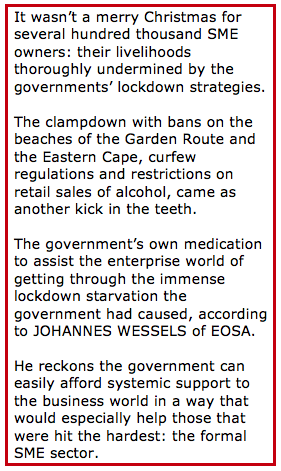Johannes Wessels
@johannesEOSA1
The centrepiece of the Ramaphosa government’s recovery and economic resuscitation scheme – the loan guarantee fund – is as helpful as giving a desperately hungry infant a dummy, pretending it is food. Not even 5% of formal registered businesses have applied for funding and by end November about 1.8% of these firms have obtained assistance from the scheme.
It is far more affordable to cut Company Income Tax and to raise the VAT threshold to get the economy growing again, than to continue with the current package of the Economic
Why the low interest in the Loan guarantee fund?

On the one hand the enterprise world was pre-lockdown already coping with difficult conditions due to an unfriendly enterprise environment with a president that is on record that he disagreed “with the view that the most effective and efficient way to provide services to our people is through the private sector.” Many business owners, especially in the case of SMEs, are reluctant to take on more debt in such circumstances, especially when running also the risk that their properties may be confiscated (expropriation without compensation).
On the other hand, the government, being out of pocket and not keen on disbursing billions that it would lose if the beneficiaries cannot service the loans, had asked the banks to apply their own existing loan assessment criteria when evaluating the applications. Were it a Khula or a SEFA process, the money would long ago have disappeared. So, despite utterances of concern about the low and slow disbursement process, the president cannot be surprised or concerned that the banks are circumspect.
In May already, EOSA had spelt out the devastating impact of lockdown measures on the enterprise world , arguing that the systemic damage caused to the spontaneous order of enterprises can best be ameliorated by a systemic response that would enable the spontaneous order to establish its own patterns again.
The government, however, kept its focus on basically two things:
- Promoting Covid-19 to the highest pedestal of dangers, wilfully ignoring all other existing problems as well as the additional problems the lockdown strategy would create, and
- Pursuing its social engineering efforts to reshape the South African economy in particular, and society at large, by limiting state relief measures to businesses complying with BEE (effectively throttling white sole proprietor businesses to death), deciding which kind of businesses are essential and which not, and pursuing anti-tobacco and prohibition agendas by bans on cigarette and alcohol sales.





 A new edited volume, published by HSRC Press, flags the importance of explicitly addressing the informal sector in such initiatives, given the key role it plays in providing paid employment and reducing poverty. The book is based on research done in the Research Project for Employment, Income Distribution and Inclusive Growth (REDI3x3).
A new edited volume, published by HSRC Press, flags the importance of explicitly addressing the informal sector in such initiatives, given the key role it plays in providing paid employment and reducing poverty. The book is based on research done in the Research Project for Employment, Income Distribution and Inclusive Growth (REDI3x3).